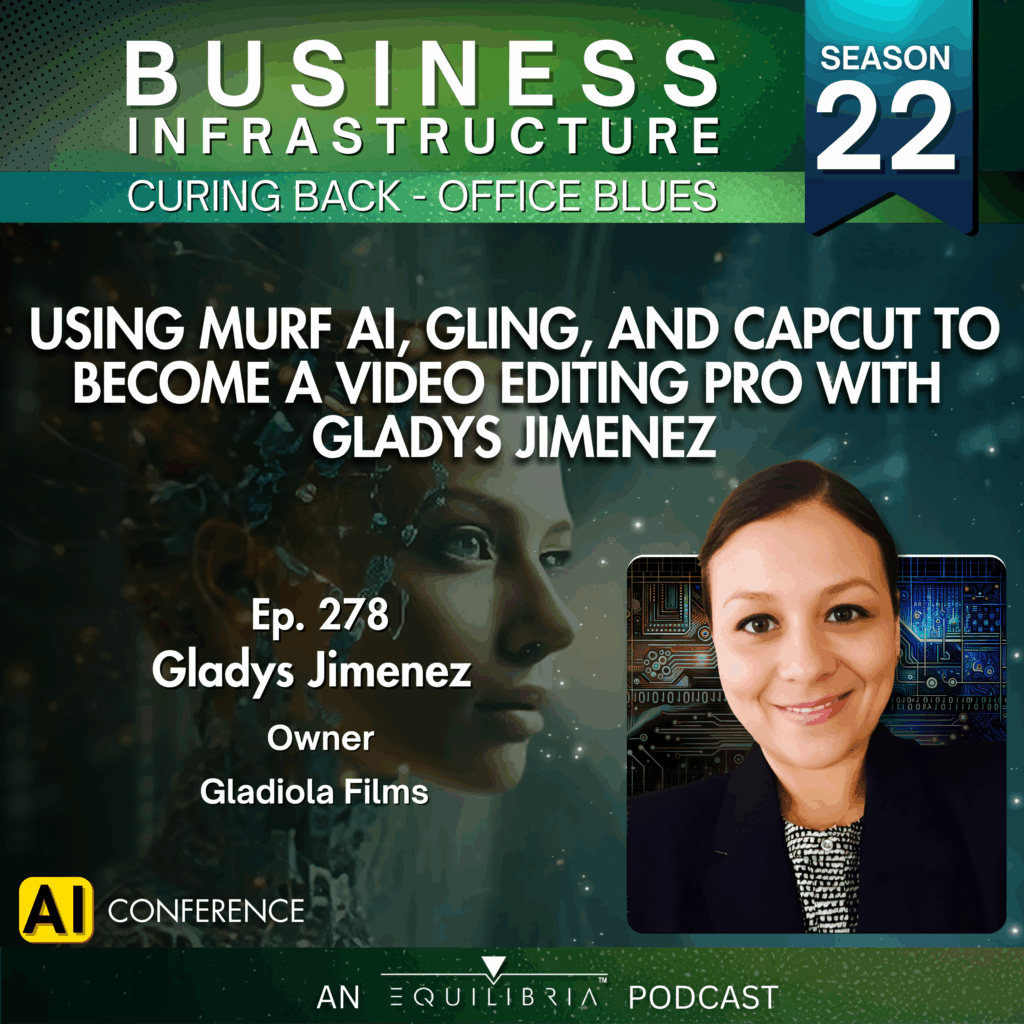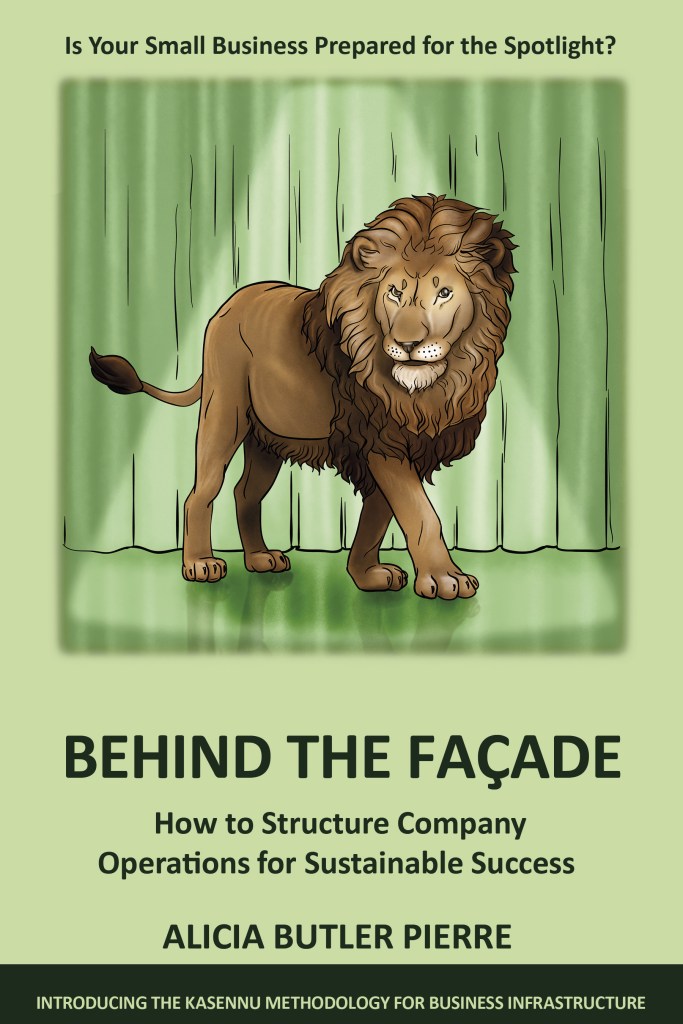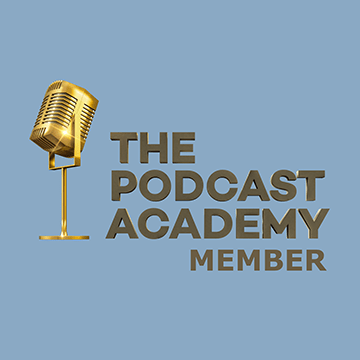Transcript
Is your small business growing faster than you can keep up with? It might be time to grow your team, document key processes, and make sure you’re using the right technologies to scale up operations. In other words, your company might need business infrastructure. At Equilibria, Incorporated we specialize in building business infrastructure.

Equilibria is proud to sponsor this special season which features an AI audio conference to advance your knowledge of business infrastructure. We hope you enjoy this episode!
It’s Season 22 here on the Business Infrastructure podcast. I’m Alicia Butler Pierre and on this show, we share operational tips, strategies, and tactics to help you cure any back-office blues you might be experiencing.
The last speaker on our audio editing conference shared her powerful business journey which included selling her photography business to Bill Gates. Interestingly, our next speaker specializes in “motion pictures,” or videos. Video editing to be exact.
As a reminder, I’ll be playing a dual role throughout this episode – part commentator, part participant – all to assist you in following along with what’s going on at the conference. Before we start, I must also remind you of our disclaimer – the nature of AI technology is changing fast, so it’s possible some of the information in this episode might be dated since the original presentation. We encourage you to learn what you can, test it, and most importantly have fun! And now for our next presentation….
This is Episode 278 – Using Murf AI, Gling, and CapCut to Become a Video Editing Pro with Gladys Jimenez.
Welcome to the AI video editing presentation. My name is Gladys Jimenez. I’m the owner of Gladiola Films. We’re going to talk about different AI tools that can leverage to speed up your video editing projects. Let’s get started.

Thank you so much! It’s so exciting to see this angle. I usually get to edit everything and see everything and the privacy of my home and just listen to Alicia interviewing. I, I love it. I, I enjoy listening to every single podcast that I’ve listened to, so I’ve become a huge fan. I’m so proud to, to work on this show. I feel like there’s never-ending information that I am constantly writing down or ordering a book from a guest. I’ll talk about it in my day to day, like, “Oh, well, I know a podcast I could help your business.” So yeah, it’s an honor to be here with you.
So let me explain my relationship with Gladys. As she mentioned, she owns Gladiola Films. She’s the mastermind behind all our video editing here at Equilibria. This includes editing every podcast episode into a video that is shared online. She’s such a superstar! And I just love her confidence. She’s so warm and personable and I can tell the audience here is connecting with her already.
When I graduated in 1996, and it was a time where, you know, video editing was becoming a little more popular. And I, I always loved stories. I always loved theater. I always loved acting and reading and being creative and music, and I did chorus, and I always wanted to be in the arts, but I needed something that would pay the bills. Once I graduated from college with an English major, there were not a lot of options. It was like, okay, either write for magazine or become a teacher. Really limited. And magazines were not doing so well during the time that I had graduated. And video editing was actually really coming up, and commercials had been big in the eighties and nineties.
So it, it was a natural evolution into, well, What can I do to make a living? And I started seeing, video editing as a profession, and I took a Final Cut editing course when I came out of college at UCLA. I realized it was the modern-day storytelling. It’s the way now people read books sometimes, even though I, I never want that to go out of style, but it really is a modern form of storytelling. And I, I saw a future in it. And, 21 years later…
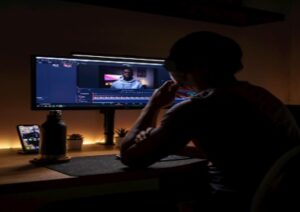
21 years later…here Gladys is! We now see an image behind Gladys on the stage. It shows the logos of companies like MTV, Buzz Feed, and Red Table Talk: The Estefans. These are some of the many companies that make up her editing portfolio over the years.
It’s always exciting to get a big name within the project. With Buzzfeed, it’s always clients like, in 2020, Joe Biden needed, a Spanish commercial campaign. And they were looking for someone who spoke Spanish, and it was during the pandemic, so it was difficult even finding work. But they are a company that have always been remote, and so they easily were able to slip into that time and have editors work for them and they found me online.
It was so exciting to be a part of that. Just last week I was working on a commercial for Walmart, for Buzzfeed, and, it’s just always exciting to know that your client is someone that people recognize. And, Red Table Talk was such a unique experience because it was a show that I could actually really believe in topic-wise.
We talked about so many different political topics, social topics in the Latino community. I’m a bilingual Spanish editor as well, and I get to work on a lot of projects that are reaching out to the Latino population, which is one of the biggest audiences in the United States and around the world. So that gives me a lot of leverage to constantly be working on projects. I feel like since 2019, where people started to be a little more aware of like social and cultural consciousness and hiring people and doing projects that had more diversity in it. So, I’ve really been riding that wave, and really enjoy those topics of conversation.
Oh wow, we’re not even ten minutes into Glady’s presentation and someone has already raised her hand to ask a question.
Okay, the question is – how long does it typically take to edit a typical Red Table Talk interview down to 30 minutes?

I think they usually calculate about two to three weeks per episode, depending on how many editors are on it. For Red Table Talk, we had two editors, sometimes a third to help out when they were available. and it really is a team effort. It takes a ton of producers, of course. Jada has the final say so it requires a lot of people’s approvals. Producers will put together a script, I take the best takes that I can find, and then I present it to them, and they watch it down, and they give me all the notes. I come back with a more refined cut; they give me back notes.
And usually, we end up with three or four versions until the final product. And that’s why I say AI helps us, but in the end, I’m really answering to my clients, the producer, the director, business CEOs, anyone who’s approving these videos. I mean, it’s basically catering to them and their needs and what kind of emotions they want to evoke out of their piece and their videos. What is the message we are sending? So, I feel like it takes a lot of human emotion and a lot of time and brains to put together a project like this. Cost-wise, we really try as fast as we can in three weeks get out something that is perfect, basically.
I’ll be honest with you – it wasn’t until I started working with Gladys that I gained an appreciation for the art and science of video editing. I’m always in awe whenever I see how she can take something like a 45-minute original or raw video from one of our podcast interviews and turn it into a highly engaging 15-minute video that not only tells a powerful story but keeps the viewer’s attention and their craving for even more content. It is indeed a process!
The process is you have to ingest it, you have to watch it, and then you have to assemble it, and you output it, the client views it, you take those notes, you re-edit, you show it, you re-edit until it’s done. So yeah, it’s a long process. The longest part is ingesting and watching it. We do have old-school AI methods, which is our editing software that ingests the footage quickly. You know, you can tell it, “Okay, I need it in by a certain amount of time,” back in the day, used to have to watch it real time in. In AI world, they speed that up for us. I would have a hard time trusting the AI only because, did they miss a key moment that was an emotional part, that I was like, Wow that would’ve been so great. So, it’s about trusting the AI tool. The more you use it, I’m sure the more you’ll know the quirks and ins and outs, but that is the most time-consuming, is really watching it and seeing what’s good.
Gladys has described the process element of business infrastructure, but I’m going to raise my hand and ask her a question about the other two elements – the people and the tools she links to her editing process.
So, as part of that ingestion phase of the overall video editing process, would you describe some of the AI tools that you’re using for video editing as more of an assisted or to potentially replace some of the people that could be a part of that overall video editing process?

I think that certain positions, unfortunately, are replaceable. For instance, the voiceover on one of my shows, we were using a temp voiceover, and the person who was doing the temp voiceover was just too busy to be able to record it. And for me, it’s important because I need someone that’s going to give me a voiceover that’s gonna have some emotion that’s going to sell the video to the executives in the network. But to the person recording it, it’s like, Oh, it’s temp. You know, it’s probably not important. They’re probably not even gonna use it. I’m only gonna give it half my oomph, you know, and they’ll take their time getting around to recording it and all that. It’s called temp vo.
Well, no, I need it right away. Like, I can’t edit without it. And so, you know, my producer found a software called Murf AI that we used. in order to bypass that delay, it costs about $220 per year, which, for me, it’s worth it. It depends on the company, you know, if they can find someone, they’d rather pay to do the AI, but in this case, I don’t think they were paying for the temp vo. But for me, it was way easier to use this Murf AI than to wait for somebody to record it.
Someone just raised his hand to ask a question. He mentioned the fact Gladys has referenced editing with emotion quite a bit. He asked if she could elaborate on that.
It took me a long time to learn how to edit with emotion. For instance, if it’s a comedy show. So many people have shared the stories on how to cut comedy or, how to make a scene dramatic. Those are the kind of things, that an editor needs to learn. And mostly we use music, sound effects and takes, like a closeup take of someone reacting or laughing or spitting up their water. Those are the shots that we used in order to make it comedic versus dramatic, you know, tears, crying, sound effects, silence, all those techniques that take years and years to learn. And, we have the technical side where we are the button pushers of this complicated software that most
people have a hard time learning.
I understand this, and that’s why there is competition coming in where there are softwares that are AI-generated for the common person that has never touched editing before. I encourage that. That saves a lot of time. Some softwares I found were like Gling, Descript, Canva, CapCut, all these software’s, TikTok, I mean, I encourage my nephew to pick up CapCut because he likes editing. I taught in Colorado Avid Editing, and I’ll tell you, this new generation was just not having it. They, they were like, “We like Final Cut Tent,” which is free and professional, you know, and I was trying to teach Avid, which is an old school software that many editors hold onto because I think it’s job security, and there is something to be said for that level. I mean, in movies, you have a director to please, and you have millions of dollars going in it.
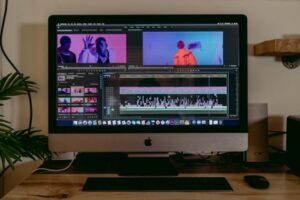
I don’t see an AI like replacing a film editor, a video editor, but for the small social videos, you know, like Canva, where you can automate that. Yes, please do. You don’t need an expensive editor to be doing small video. If it can automate and it doesn’t need emotion or drama, then go for it. Use these softwares. Make ’em even blingier. I mean, some of the CapCut stuff, I’m like, Whoa! How do you do that? would be hard for me to do. but I think Adobe is a really good software that’s competing with, I think, some of the AI video editing. And you still have to pay and learn how to use the AI video editing software. So, it’s not like it automatic, like I was
playing around with it.
And it does remove bad takes. It will suggest where to edit, but you still have to execute it. When it comes to movies and commercials and, and big projects, a documentary, you’re always going to need an editor who feels the emotion, who’s watching the takes and goes, Wow, that really moved my heart. Wow. I could feel that they’re in their homeland. It may be replaced in the future, but it would be super expensive to replace a human being.
As Gladys said that she walked over to the podium on the stage where there’s a laptop. She said she’s about to give a demo of Murf AI. It’s the first video editing tool she mentioned. She’s told us we’re about to hear an AI voiceover using different emotions to prove her point why editing for the right emotion is so important in storytelling.
Well, I was working away probably at midnight, because I never received this voiceover. And so, I started playing around with this Murf AI, and basically, they allow you to sample for free which is nice. So, I typed in a sentence. Here is Natalie’s voice in conversation.
During my stay at the Holiday Inn, I slept peacefully in the softest bed.
You can kind of hear it’s a little bit of an AI voice. I’ll just play it. You can also play with different styles of reading like promo newscast, sad, angry…let’s hear angry.
During my stay at the Holiday Inn. I slept peacefully in the softest bed.
It’s a little bit of an intonation, but if you can see here, you can play with the pitch, you can play with the speed, you know, so you can, if like, like I wrote out this letter, this word that said “AI,” and it makes AI sound weird.
My name is Natalie and I’m here to talk to you about AI.
So it’ll pass for tempo and maybe if I learn to, you know, tweak the pitch and the speed a little bit, then it’ll sound a little better and I’ll be able to present it to the client.

Okay, let me explain what Gladys just did. She opened a tab on the Google Chrome browser and typed in Murf.AI. That’s M-U-R-F.AI. Once she logged into her account, we saw a screen with different text fields in the center of the screen. Gladys typed in the sentence you just heard into one of the text fields.
We then saw a dropdown list containing different names. Gladys selected “Natalie.” There’s also another dropdown where you can select the tone of the voice (for example, “conversational” or “sad,” or “angry”). She then clicked a play button next to the text field so that she could demonstrate Natalie’s voice repeating the sentence she just typed. There’s also options for adjusting the pitch of the selected voice as well as the speed.
You could put a whole transcript in there. And they have all different kinds of voices. And they also have different languages. So, I use the Spanish version. So they have Spanish from Mexico, Spanish from Spain, they have Spanish from, from different countries like Argentina.
It only takes one voice at the right pitch to start an avalanche.
Now that was really good! It actually sounded human.
Certain words sound better than others, once again, it’ll take a little tweaking to make it sound better, but it’s definitely better than nothing.
And, as with many technologies, it’s only going to get better over time.
I mean, this impressed me. And, Adobe Audition, which is their editing audio software, they have a free one, which I use as well if it’s temp vo. Okay, so that is one software. And then this one, which I was pretty impressed about…this Adobe Podcast, basically you can put in your audio that’s got, background noise and it can make it better. So, this is their sample on their website of before and after cleaning up the audio.
Gone as if I recorded this in a professional studio…
Enhanced…
I’m in a conference room with the window open. And it’s pretty echoey in here too. Not the best place to record audio yet with enhanced speech. All of the background noise and echo is gone as if I recorded this in a professional studio.
Wow! Let me tell you why this is so important. As a podcaster, the number one enemy is background noise – things like babies crying, dogs barking, sirens…it ruins the quality of the audio. If this ever happened during a recording, we would literally have to stop, wait, and repeat certain sections. But Adobe Podcast can remove that without any rework – amazing!
And this is the thing it’s usually inexpensive editing software I can clean that up for you in my video editing software, but the fact that you could do it on a podcast, and I feel like podcast is really, you know, up to the playing field too cause there’s a lot of people that now have audio recording. And usually, people don’t value audio as much as video. But I tell you, it seeps into the brain subconsciously where if, you know, audio is bad or it’s distracting and you don’t know why you’re irritated.
I have another question for Gladys…

There were some other tools that you mentioned kind of quickly. Can you mention those again? There was something that has to do with TikTok, like CapCut. I’m not a TikTok user, so forgive me if that’s something that everyone who’s a TikTok user just automatically knows. But I, I have no idea what that is.
It’s called CapCut and it can be on Windows, it could be on Apple. It’s very versatile. It’s basically an easy-to-use editing software and it formats for TikTok. So, if you are scrolling through TikTok, you’ll see Made by CapCut or they’ll have, filters that you can use through CapCut. So, it’s become really popular. I love TikTok ’cause I feel like I’m back in my film school days where people are making their content and it’s for free. You know what used to cost millions of dollars for a commercial on TV is now anyone can make a commercial. I feel like that’s so powerful, to be your own artist.
Someone else just raised his hand to ask Gladys a question. He wants to know if there’s video editing software that can be used to do something similar to Murf AI. In other words, what are some AI tools she recommends where, based on video you upload, it will make suggestions on where to cut based on the type of emotion you select.
Well, a couple of ’em. One is called Gling and I was just playing around with Gling, G-L-I-N-G and Descript.
They both are AI video editing softwares. They can’t edit for the emotion. So, you select the music, you know, you upload the music, it will eliminate takes that were bad or when you’re speaking and you repeat yourself, it’ll gray out the part that it thinks should be cut, I feel like that’s really helpful. I would use one of those to do one of my home movies, you know, Gling, Descript, even CapCut to make…I think CapCut might be shorter videos, I’m not sure but definitely Gling and Descript are worth trying.
Hearing what Gladys just said made me think of another question to ask her.
In your day to day, typical project…which of these AI tools are you using, would you say the most?
Well definitely the music polls. There’s one where actually most music libraries now where you sign up for a subscription for the year and they allow you to use the music that’s licensed. They have, composers that compose for these music libraries. Now they have where you can import a song and it will find you a ton of samples that are similar. So, if I put, oh, you know, merengue, it’ll find a bunch of merengue. And the more specific you are, the better with AI.
So, in that case, that’s really helpful when it can find music ’cause that used to be what assistant editors did and they’re already overrun with so many other things that they need to do that these kinds of tools where the library can find a ton of music that’s very helpful to an editor cause that could take hours to find the right song. Shazam, which I always use, that’s now a software that, was invented in 2002 and sold to Apple and now you get it on your phone. So, I use it every time I hear a funny song on, you know, Instagram or TikTok and I wanna use that song, it finds it right away.
Those same AI editing software that we mentioned, they can also produce transcripts for producers to use that help eliminate, paper editing through the transcripts, which a lot of people still use that. and Adobe Fonts is another one I love that whole Adobe suite. They’re always trying to make things better. They have the same kind of thing with the music where you find a font, let’s say Walmart. I had to do that the other day where I had to match Walmart ’cause they wanted more words than the logo that they gave me. So, I had to match the words to Walmart and I put that in and they were able to find, the same font or a similar font and it matched perfectly.

Okay, another person just asked about the AI tool Gladys mentioned for finding music.
It’s Warner Chappelle and Universal Music are two libraries that, that I’ve used.
Don’t get me wrong, all of these AI tools for voice and video editing is great! But I can’t help but wonder about the learning curve for those of us who are amateurs. So, I asked Gladys about this.
Yeah, I mean, if you want to edit your own videos at home, I will definitely try one of these AI video software with CapCut, Gling, Descript. ’cause they’re made for someone who’s never had to edit before. if I was pursuing an editing career, I would definitely learn one of the three software which is Adobe Premier, Final Cut Pro, or Avid. And those are the more advanced software that are complicated to learn. But it’s like driving a car, once you know where all the buttons are and how to maneuver, you’re able to be just fine. And the more you do it, the faster you do it. And, I love doing home projects. I had a brilliant editor once say, Do your home
movies. That’s literally how you learn to cut. Hearing people’s feedback is really important too, in knowing how to take criticism and critique.
I once was a novice and a fellow coworker told me they, I cut all the emotion out of the scene and I was like, Oh, that hurts. But you know. It’s about getting feedback. I say constantly be reading about how to edit because there is so many articles now online. I mean, when I was learning, there was barely any resources. I have a whole bunch of books. I have, Avid Editing, which I taught in Colorado. That’s a basic book. And it is taught in a way where you have lesson plans, the author is Sam Kaufman. And basically, you can do one exercise to another. And if you read this, you could literally start to be a professional video editor.
Another one that’s great is In the Blink of An Eye by Walter Merch. That’s an oldie but a goodie. And basically, he’s a movie editor for Francis Ford Coppola and he talks about how to edit. for instance, many people don’t notice, but like, when you blink, it’s almost like you’re saying yes, or you understand it’s a subconscious thing. And so, he talks about before the blink, after the blink, those kinds of techniques that an AI machine is not gonna necessarily know how to make those calls. Like, you know, Editing for Reality TV. Jeff Dawson, this is another guy who’s an editor. And I’ve actually contacted him ’cause he changed my life because who teaches you how to edit for Reality TV. This was a really good resource ’cause he basically talks about how to create stories from scenes, what to expect when you’re sitting in the editing chair.
Cause it really is such a secretive job. Like it’s hard to explain what it is. no one really lets you into the room to see what they are really doing. ’cause it’s almost like a skill where it’s like, I learned my dues and I’ve paid my dues and now I have deadlines. So, it’s really hard to be mentored. So, when you find someone that can mentor you, that’s huge too. And they say, you don’t pick your mentor, your mentor picks you. Which I feel like that happens. It’s like you can’t predict it. You just find someone that’s willing to take you under their wing that believes in you. You work really hard, and someone will give you the opportunity, you know.

It’s a great career and I don’t see it ending anytime soon. I mean, we have things like the strikes and all that. And still, we thrive because people need entertainment. People need information. The news, documentaries, so many ways of communicating, expressing, it’s changed the world. And hopefully the AI just keeps making it that much better because we’re used to change,
people in film – it moves from no sound to sound. And now we’ve got black and white to picture, and now we have picture to HD and now we have 4K, 8K, 10K, 3D, it’s just gonna keep going and going, you know, so we have to roll with the times.
Uh oh, the moderator just gave Gladys a queue that her time is up…Gladys, I think I speak for everyone when I say we can’t thank you enough for sharing these AI video editing resources!
Thank you!
If you want to connect with Gladys, the best way to do that is on LinkedIn. Just look for her at Gladys Jimenez. Or, you can always head over to BusinessInfrastructure.TV. There, you’ll not only be able to quickly access her LinkedIn profile, but you’ll also get links to all the software and books that she mentioned. Again, that’s BusinessInfrastructure.TV.
Thank you for listening! If you enjoyed this episode, then please subscribe and give us a five-star rating and review.

Now that you have more AI tools to add to your toolkit, it’s time to take a break from the demos and head on over to our next keynote speaker. We’ll meet be back soon with that discussion.
Make sure you come back to the place wherever you’re listening to this episode, so that you don’t miss this keynote! Until then, remember to stay focused and be encouraged. This entrepreneurial journey is a marathon and not a sprint.
This episode was produced by me, Alicia Butler Pierre. Audio editing by Olanrewaju Adeyemo. Voiceover by Kenya A. Moses. Original score and sound design by Sabor! Music Enterprises. Video editing by Gladiola Films. A special thank you to Grant Revilla for creating the show notes.
This is the Business Infrastructure – Curing Back-Office Blues podcast.


